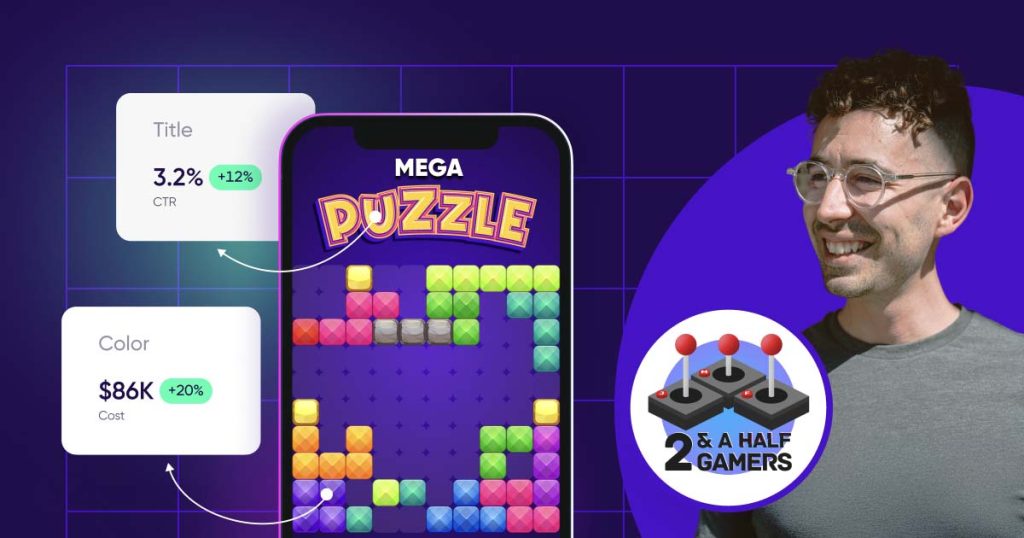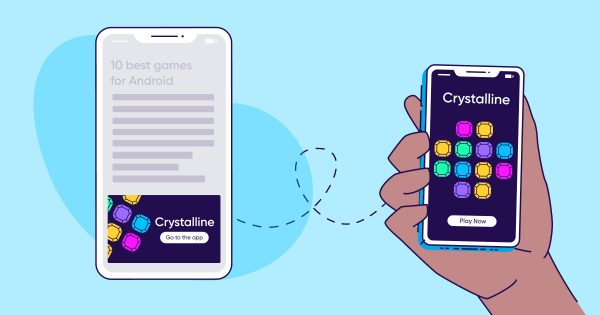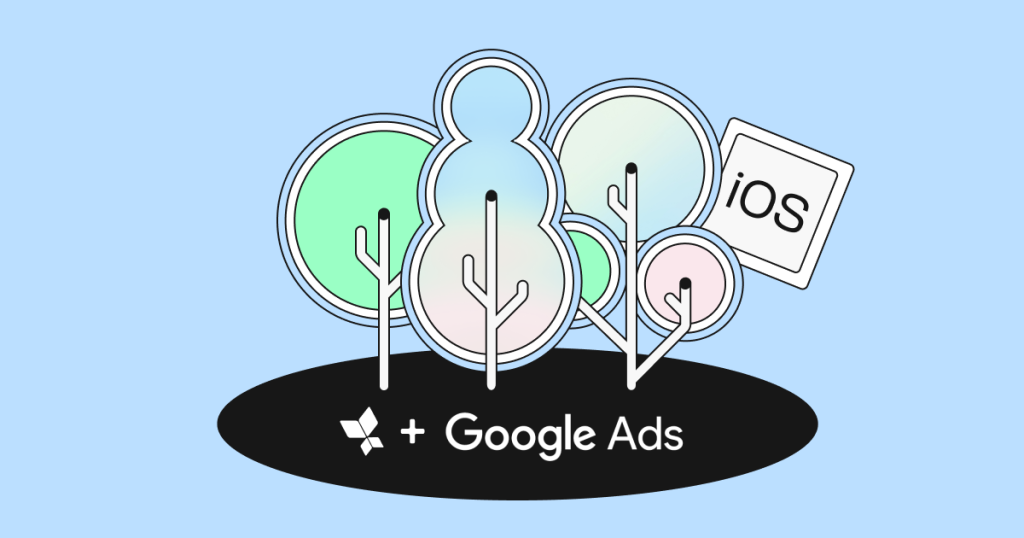Your no-BS guide to successful ad creatives


In a market flooded with apps, the success of your marketing efforts depends on one key element: your ad creatives.
Regardless of how precise your targeting or polished your campaigns may be, you need ad creatives that hook, persuade, and stick with customers.
For instance, Nielsen discovered that creativity influences 56% of a campaign’s sales ROI (return on investment). And Google states that creative aspects determine 70% of a campaign’s success.
That’s how much your creatives matter. Yet, in the face of short attention spans, shifting customer tastes, and tight ad budgets, developing winning creatives is no easy feat.
This blog digs deep into the crucial role of creativity in crafting memorable ads. Read on to explore the essential components and innovative strategies that breathe life into high-performing ad creatives.
What are ad creatives?

Ad creatives are the visual and written components of advertisements that grab the target audience’s attention and convince them to take a specific action. This could be downloading an app or signing up for an app subscription, for example.
Good ad creatives have four key elements:
- Visual design: This is about eye-catching images, illustrations, or videos. For instance, a fitness app might use vibrant images of people working out to convey its message effectively.
- Ad copy: This refers to the persuasive and concise text accompanying the visuals. A food delivery app, for example, could use enticing language like “Hungry? Order now for fast delivery!” to spur audience action.
- Call-to-action (CTA): A strong CTA prompts viewers to act, whether it’s installing an app or making an in-app purchase. For instance, a gaming app can use a CTA like “Play Now” to encourage immediate engagement.
- Branding: Ad creatives should consistently reflect the brand’s identity through elements like logos, color schemes, and visual style. Say you want to encourage online banking customers to manage their money via the app. Your ads should use the same logo, colors, and tone of voice they know and trust from your website.
Why are ad creatives important for your marketing campaigns?
Ad creatives serve as the face of your brand that the audience sees. Here’s why they matter for effective app marketing:
Captures attention
Audience attention is a scarce commodity today, which makes ad creatives indispensable. Ads with compelling visuals and engaging messaging stand out from the crowd, ensuring they catch people’s attention and make them notice your brand.
Communicates brand identity

Ad creatives show what your app and brand is all about — its personality, what it stands for, and what it wants to say. Through carefully crafted visuals and persuasive copy, you can create a distinct brand personality that resonates with the target audience.
Moreover, when ad creatives are consistent and tell a clear story, people can understand and connect with your brand better. This makes them more likely to remember and stick with your mobile app over time.
Fosters consumer engagement
Engaging ad creatives get people interested and involved.
Whether it’s thought-provoking imagery, witty copywriting, or interactive elements, great ads make people want to take action. This could mean liking, sharing, or commenting on the ad — or even installing your app.
By creating a dialogue with the audience, ad creatives facilitate a sense of involvement and ownership, helping your app grow.
Enhances brand visibility
In a crowded market where apps fight for attention, ad creatives serve as the first line of defense.
A cool and memorable ad can make your app stand out, ensuring it remains top-of-mind for consumers. When you keep putting out impactful creatives across various marketing channels, you get into people’s heads, ensuring they remember and recognize your app better.
Drives consumer action
Ultimately, an app marketing campaign’s success hinges on its ability to drive consumer action. And ad creatives that show what the app is about and capture people’s interest are more likely to give them that needed push.
Whether it’s clicking on an ad, making a purchase, or leaving a review, ad creatives that resonate with consumers can influence behavior and drive tangible results. This, in turn, contributes to increased sales and revenue for your app.
Ad creative best practices
Follow these six tips and take inspiration from leading brands to give your creatives the best chance of success.
1 — Know your target audience
When you run an ad, each click costs you money. To optimize your ROAS, you must tailor your ad creatives to resonate with your target audience. And the first step to doing this right? Knowing who these people are.
Start by identifying similar brands’ audiences and analyzing their best-performing posts for insights into ad copy, visuals, and CTAs. Experiment with various content formats to engage directly with your audience’s needs, interests, and preferences.
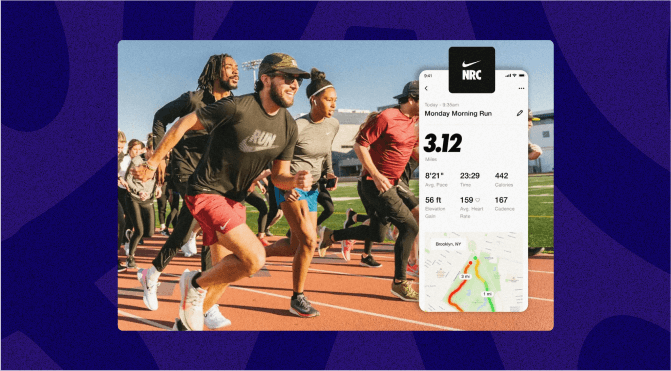
Nike’s Run Club app, for instance, often shows people of all ages and backgrounds running. This makes sure the ad appeals to runners of any level.
2 — Emphasize the benefits or USP of your app
Highlighting the benefits or USP of your app in creatives helps you:
- Capture the audience’s attention and arouse interest
- Differentiate your product from competitors
- Convince users to choose your app over others
Even better if you can reinstate your value proposition or product feature by actually showing them to the customer, but we’ll discuss this in detail later.
Take the meditation and relaxation app Calm, for example. The ad creatives from the brand feature serene imagery and calming sounds, underscoring the benefits of stress relief and better sleeping patterns.
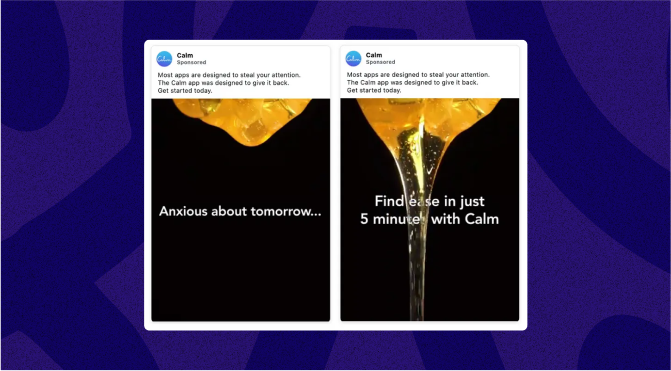
This beautifully showcases Calm‘s ability to provide relaxation and peace of mind, enticing users to try the app out.
3 — Tell a story
Picture this: a couple enjoying coffee on a beach in an ad for a coffee brand. Or watching friends having fun exploring a city in an ad for a travel company.
Notice how in both ads, the product is part of the story. When you use storytelling in an ad creative, you’re not just selling — you take the viewer on a journey and make them feel something. This way, you create deeper connections with the viewers, which is always helpful in advertising.
Recently, language-learning app Duolingo placed ads on London’s roads, railways, and Underground. These creatives talked about how much time Londoners spend traveling and suggested using Duolingo as a good way to make that time productive. Brilliant, right?
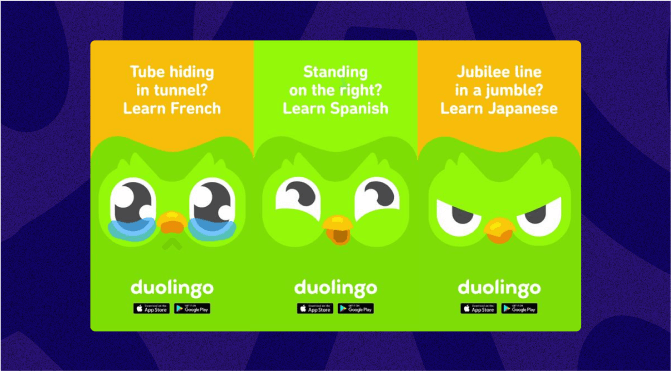
4 — Show your value proposition, don’t simply describe it
Just talking about your app’s value proposition isn’t enough. You need to bring it to life for users.
Use your creatives to help users understand how your product can solve their problems — or fulfill their needs — to make the whole exchange more compelling.
Take this Grammarly ad creative, for example:
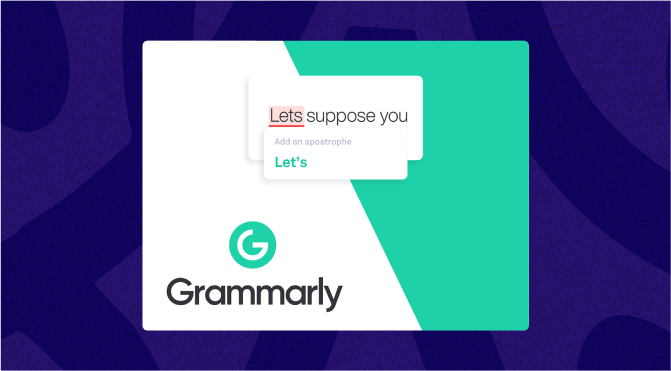
In the ad, Grammarly shows how writing looks before and after using its app. Viewers can see how the writing assistant tool makes writing clearer and corrects mistakes — and being able to see these benefits means they’re more likely to actually try Grammarly.
Another great example is IKEA Place, an app that combines catalog browsing with Augmented Reality (AR). One look at its creatives, and you know exactly what the app offers: the ability to see how IKEA furniture would look in your home.
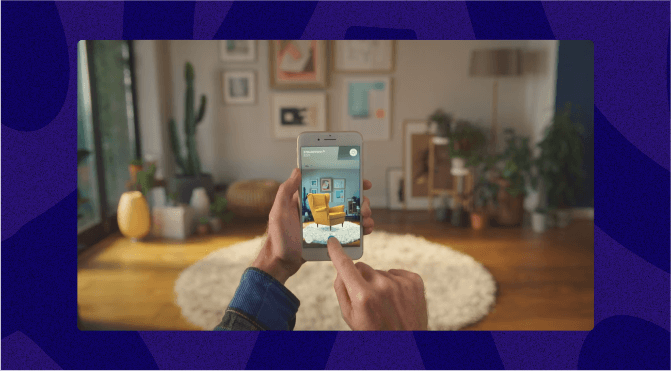
5 — Work with great content creators and influencers in your niche
Collaborating with professional content creators and influencers is another way to create engaging ad creatives that get results.
How does this work? Influencers generally have a strong presence in your target niche, which helps amplify your brand message and grab more eyeballs for your ads. Plus, these individuals create authentic content that resonates with their followers, leading to increased brand awareness and credibility.
Take a cue from Tinder. Instead of pushing its service in the traditional (read: salesy) style, the brand works with influencers to create engaging content that draws people to the brand.
Check out this video to see what Jenny Campbell, Chief Marketing Officer at Tinder, says about using influencers to tell authentic stories that stick:
What’s more, creating original content from scratch daily isn’t feasible for everyone. Collaborating with content creators gives you quality ad content while freeing up time to focus on other tasks on your to-do list.
6 — Use high-quality images and vibrant colors
The right image or graphic can make your ad stand out in an already crowded digital space.
But how do you make sure your visuals pack that punch? Here are some tips:
- Match visuals with the message: Make sure your visuals complement and reinforce your ad’s message. Imagine showing a picture of a sunny beach when you’re selling snow boots — that’s a mismatch!
- Use high-quality images: Always opt for clear, sharp images to maintain your brand’s credibility.
- Experiment with vibrant colors and contrast: Bright colors and high contrast practically scream, “Look at me!” So don’t be afraid to make your ad more eye-catching.
- Include relevant imagery: Choose images that make sense for your product or service. You wouldn’t want to show a picture of gardening tools when advertising a game about dragons, would you?
The New Yorker effectively applies these best practices to its ad game.
In this ad, for instance, the company targets its audience and uses a smart color scheme to promote a limited-time offer. The light background highlights the colorful totes and the deal, while the themed CTA assuredly grabs attention for action.

Which KPIs should you measure?

Post launching an ad campaign, you must keep an eye on specific metrics and KPIs to understand how your ads are performing.
Here’s a quick list:
- Impressions: Impressions indicate how many times your ad appears on someone’s screen. It serves as the initial check metric to measure the reach and visibility of your creative content, but viewed in isolation it doesn’t tell you about engagement levels.
- Three-second video viewers ratio: This metric goes beyond impressions, showing the percentage of viewers who watch your video for at least three seconds compared to total impressions, indicating the level of engagement with your content.
- Average watch time: Average watch time calculates the total duration viewers stay tuned to your video content. Use it to understand how effective your ad is at attracting and retaining viewer attention.
- Click-through rate (CTR): CTR calculates the percentage of viewers who click on the provided link or complete your desired action after engaging with your ad. It indicates the success of your CTA in inspiring action.
- Conversion rate (CVR): CVR measures the percentage of viewers who take the desired action after seeing your ad, indicating the success of your marketing campaigns.
- Cost per acquisition (CPA): CPA tracks how much you’re spending to acquire each new lead or user. Think of it as a budget management metric to control acquisition costs.
- Cost per click (CPC): CPC shows how much it costs for each successful conversion. It helps you see how well your ads are working and decide where to spend your budget wisely.
- Ad spend: Ad spend represents your total investment in advertising campaigns. It’s a crucial metric to track for managing marketing budgets and ensuring spending remains on track.
- Return on ad spend (ROAS): ROAS indicates the total revenue generated as a result of ad spend. It offers insights into the profitability of your advertising campaigns and whether they provide a positive return on investment.
- Return on investment (ROI): ROI compares the total revenue generated from marketing efforts to the total investment, assessing the overall effectiveness of marketing campaigns in generating profit for the business.
Challenges in managing ad creatives

Of course, brilliant creatives don’t just happen. Getting this stuff right takes time and skill, and you’ll face challenges along the way. We’ve outlined the most common difficulties below — but don’t panic, because we’ve got the solutions too!
1 — Maintaining your brand voice
Ensuring consistent brand messaging and tone across different ad creatives can be challenging. More so when multiple teams or individuals are involved in the creation process.
Solution: Establish clear brand guidelines outlining voice, tone, and visual style. Teach and give resources to teams making content so they stick to these guidelines.
2 — Scaling across ad formats and various social platforms
Making ads look good and clear on different platforms is hard, especially because digital advertising keeps changing and expanding.
Solution: Invest in automation tools like Celtra and pre-made design templates to streamline the process of resizing and formatting ad creatives for different platforms. Also, use data-driven insights to prioritize social platforms where your target audience is most active.
3 — Collaborating across multiple teams
Collaboration between creative teams, marketing teams, and other stakeholders is crucial for successful ad campaigns. However, communication gaps and conflicting priorities can hinder collaboration, leading to disjointed ad creatives.
Solution: Implement project management tools like Asana and create workflows to help teams work together better. Establish clear roles, responsibilities, and approval processes, aligning everyone throughout the creative development process.
4 — Performing A/B tests for creative elements
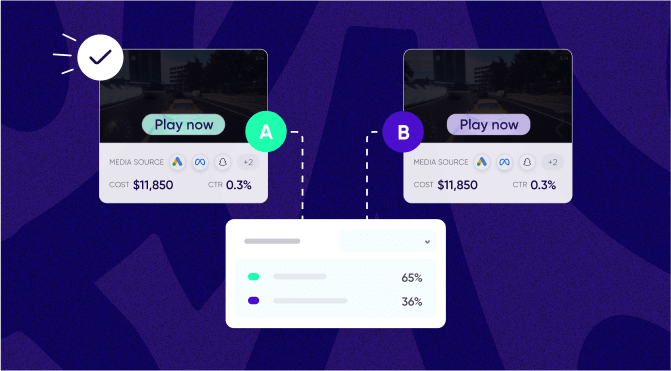
Testing different creative elements such as visuals, messaging, and calls-to-action is essential for optimizing ad performance. The challenge here is designing and implementing A/B tests in a way that ensures accurate results.
Solution: Decide what parts of ads are most important to test based on campaign objectives and audience insights. Use A/B testing tools and methodologies to systematically test variations (visuals, copy, and CTAs) and analyze performance data to identify winning creatives.
5 — Adapting creatives for each customer journey stage
Tailoring ad creatives to resonate with customers at different stages of the buyer’s journey requires a deep understanding of customer needs and preferences.
Solution: Develop a comprehensive content strategy that maps out the customer journey. Tailor creatives to address the specific needs and motivations of users at each stage.
Impact of AI on ad creatives

With its amazing data analysis and predictive abilities, AI has completely changed how marketers optimize their creative strategies. Here’s a brief breakdown:
Ability to test individual elements
AI-powered analysis helps you understand what works best with your audience, guiding smart creative decisions. For example, AI can pinpoint specific elements in a video ad that drive better results, like the number of people featured or the tone used.
Analyze data faster
AI processes vast amounts of data swiftly, revealing subtle patterns and insights that you might easily miss. This speed enables you to make decisions faster and optimize ad creatives for maximum impact.
Hyper-personalization at scale
AI enables hyper-personalization at scale by analyzing individual user data. This means you can tailor ad content to align precisely with each user’s preferences and needs, ultimately boosting engagement and conversion rates.
Real-time optimization
AI also continuously monitors and optimizes ad performance in real-time. You can use it to adjust bidding strategies, creative elements, and targeting parameters on the fly to ensure best results.
Ad creatives with AppsFlyer
With AppsFlyer’s Creative Optimization, managing ad creatives becomes effortless. This tool uses AI to provide insightful guidance, helping you refine your campaigns. By analyzing your creative assets and identifying important trends, Creative Optimization enables you to make informed, data-driven decisions, ultimately improving your ad performance and efficiency.
Featuring AI-driven insights and detailed performance data aggregation, Creative Optimization makes it easy to optimize your ad spend and identify successful creative strategies. It’s already helped businesses across various sectors, including gaming, fintech, eCommerce, and entertainment. They’ve seen significant improvements in critical app KPIs, such as increased click-through rates, reduced cost per install, and improved customer retention and revenue metrics.
Key takeaways
- Ad creatives are the visual and written components of advertisements that grab the intended audience’s attention and encourage them to take action.
- Ad creatives play a crucial role in marketing success. Creativity influences sales ROI significantly, and creative aspects determine a substantial portion of campaign performance.
- Essential components of ad creatives include visual design, compelling ad copy, effective CTAs, and consistent branding — all of which contribute to engaging and memorable advertisements.
- Successful ad creatives not only capture attention but also effectively communicate brand identity. Other benefits include boosted consumer engagement and increased brand visibility, which ultimately prompt desired actions from the audience.
- Employing best practices such as audience targeting, highlighting unique benefits, incorporating storytelling, and showcasing value propositions can significantly enhance the effectiveness of your ad creatives.
- Using vibrant, high-quality visuals and collaborating with influencers in your niche will also help your creatives stand out in today’s crowded digital landscape.
- AI has revolutionized the way marketers develop ad creatives, thanks to precise testing, rapid data analysis, hyper-personalization, and real-time optimization.
- AppsFlyer’s Creative Optimization, powered by AI technology, provides in-depth insights and guidance for optimizing ad creatives, resulting in improved performance across diverse industries, from gaming to eCommerce.






